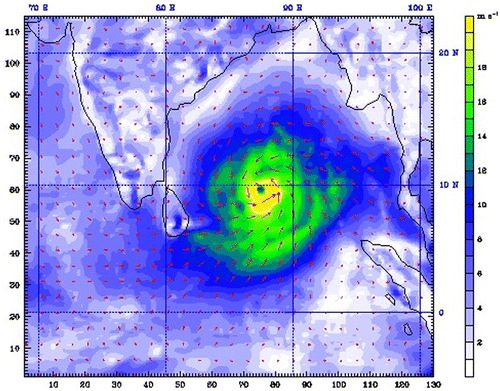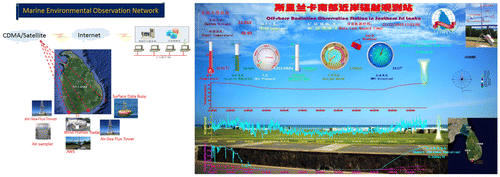Abstract
The China–Sri Lanka Joint Center for Education and Research for the 21st Century Maritime Silk Road (CSL-CER) was established in August 2015. The Joint Center is an overseas science and education platform established by Chinese Academy of Sciences. CSL-CER has conducted a series of research activities, including an annual scientific expedition to the eastern Indian Ocean, with many kinds of instruments installed for monsoon and ocean observation. The ‘Numerical Forecast System for the Surrounding Area of Sri Lanka,’ which was developed by the Joint Center, can provide rapid mapping on multiple scales and at multiple resolutions for numerical forecast products serving local society. The annual China–Sri Lanka Joint Workshop on Monsoon Climate and Ocean Environment was successfully held in 2015 and 2016. According to the Memorandum of Understanding (MOU) on joint Master’s degrees, 15 new Master’s students were accepted by University of Chinese Academy of Sciences (UCAS) in 2015.
摘要
中国-斯里兰卡联合科教中心成立于2015年8月,为中斯两国间科教合作搭建平台,并在南亚季风爆发核心区域建立海洋大气相关实地观测系统。中心承担每年一度的印度洋科学考察航次,在赤道和北印度洋等海域布设潜标和临时观测站,研究印度洋环流动力构成和相关海洋动力特征。并在斯里兰卡布设了多种探测季风和近岸海洋观测仪器,为斯里兰卡提供了多次度和多分辨率的“斯里兰卡周边区域海气数值预报系统”。中-斯中心在2015年和2016年连续举办两届中-斯联合季风气候和海洋环境研讨会,会议促进了两国间的海洋大气科学研究的交流。在联合硕士计划备忘录的签订后,2015年15名硕士研究生新生被中国科学院大学录取。
1. Introduction
The China–Sri Lanka Joint Center for Education and Research for the 21st Century Maritime Silk Road (CSL-CER) was founded in August 2015. The Joint Center is an overseas science and education base of the Chinese Academy of Sciences (CAS), whose supporting institution is the South China Sea Institute of Oceanology, CAS. Other participants include the Bureau of International Co-operation, CAS. The building organizations are the Research Center for Eco-Environmental Sciences, CAS; the Institute of Acoustics, CAS; UCAS; the University of Ruhuna; the University of Peradeniya; and the University of Moratuwa. The Chinese Director of the Center is WANG Dongxiao, a Professor at the South China Sea Institute of Oceanology, CAS.
The Indian Ocean is the third-largest ocean, and is thus very important in oceanographic research. The Indo-Pacific warm pool is the energy center of the world’s oceans, where the strongest global mass and energy exchanges occur. The tremendous thermal potential of the Indo-Pacific warm pool has an important impact on climate variability in Southeast Asia and serves as a major source for low-frequency dynamic wave trains, as well as the ‘bridge’ influence of the tropical Indian Ocean and eastern Pacific Ocean on the East Asian monsoon, a phenomenon controlling disasters such as drought, flooding, and typhoons in China, and regulating global climate change.
2. Scientific expedition in the Indian Ocean
Before CSL-CER was established, in 2010, a research vessel (Shiyan No. 1) of the South China Sea Institute of Oceanology, CAS, begun to implement an annual scientific expedition in the eastern Indian Ocean (Figure ), arranged by the National Natural Science Foundation of China, which is the foundation of the CSL-CER. By 2017, it had accomplished five successful voyages, covering a total of 474 days and 73,894 nautical miles (Table ), making it the scientific expedition covering the widest sea area in the Indian Ocean, the longest cruise range, and the most comprehensive scientific investigation by China. In the past seven years, more than 20 domestic institutions have participated in the scientific investigations in the Indian Ocean, including CAS, the State Oceanic Administration, the Chinese Academy of Meteorological Sciences, the Navy Unit, Tsinghua University, Beijing University, and Xiamen University.
Figure 1. Indian Ocean research cruise map in 2015 (left) (Source: 2015 survey cruises report of SCSIO) and recovery of deep-sea subsurface mooring in 2014 (right).

Table 1. Expeditions in the Indian Ocean.
Through the Indian Ocean survey cruises, precious first-hand data have been accumulated on hydrology, meteorology, chemistry, marine biology, environmental ecology, and marine geology in the Indian Ocean. These data are meaningful to ocean research in China.
3. In-situ observation system and application forecast model
Since the foundation of the real-time observation network of the Joint Center, monsoon observation has obtained continuous data for more than four years (from the end of 2012), with data received at a rate of over 94%. The nearshore wave and tide observation station, since its foundation on 23 September 2013, has obtained consecutive wave and tide data for more than 11 months, with data received at a rate of more than 85%. Later, in May 2015, an automated weather station (AWS) (Figure ) was founded, which has the capacity of measuring the meteorological parameters of wind speed, direction, air temperature, air humidity, shortwave radiation and rainfall. Subsequently, the AWS was upgraded in September 2016, with a wind profiler that has the ability to measure wind speed and wind direction at distances of 0–800 m. It has a data output interval of 20 min and is expected to operate for a period of two years. The latest addition to the AWS is the Atmospheric Boundary Layer Observation Tower, established in March 2017. This possess the ability to measure air–sea heat flux, CO2 flux, wind speed, wind direction, air temperature, air humidity, and solar radiation.
At present, Sri Lanka lacks a relatively mature numerical forecast system, which makes it quite vulnerable when facing marine disasters. The ‘Numerical Forecast System for the Surrounding Area of Sri Lanka,’ which was developed by the Joint Center, can provide rapid mapping on multiple scales and at multiple resolutions for numerical forecast products (Figure ). These products can forecast environmental factors such as typhoon path, storm surges, and tide level. This forecast system can provide support to decision-making for the administrative departments responsible for disaster prevention and mitigation, fishing and shipping, so as to improve their capacities for disaster management and to reduce the damage of Sri Lankan people’s lives and properties caused by natural disasters.
Figure 3. An example for the tropical cyclone forecast (created by the Numerical Forecast System for the Surrounding Area of Sri Lanka).

So far, the model has already accurately predicted the combined superstorm of ‘Feilin’ in the Bay of Bengal, ‘Baihe’ in the South China Sea, and ‘Weibo’ in the West Pacific. The heavy rain process of tropical cyclone TC01B was also accurately predicted.
4. China–Sri Lanka cooperation on education and science
4.1. International exchanges and visits
Proposed by YUAN Yeli (Academician, Chinese Academy of Engineering) and Professor SHI Ping, the International Workshop on the Tropical Marine Environment was first held in 2001 and scheduled once every two years thereafter. Since then, it has been successfully run on seven occasions. The conference has become an important academic communication platform for research scientists, national and international, working on the South China Sea and the tropical oceanic environment, and has had a marked impact on related academic fields worldwide. For three consecutive years, researchers from the University of Ruhuna have been invited to give a presentation at the workshop, discussing hot topics such as the variability of the Indo-Pacific warm pool and its environmental effects. Prof. Senanayake, Vice-Chancellor of the University of Ruhuna, Prof. Tilak, Dean of the Faculty of Fisheries and Marine Sciences and Technology, and Dr Pradeep, Head of the Oceanography and Marine Geology Department, have each paid many visits to the South China Sea Institute of Oceanology. The University of Ruhuna and the South China Sea Institute of Oceanology have conducted fruitful and deep discussions on topics such as making more effort regarding joint offshore observations of the marine environment and joint investigations of the marine ecological environment and resources, which has laid a solid foundation for practical cooperation between the two parties.
4.2. The First China–Sri Lanka Joint Workshop on Monsoon Climate and Environment
CSL-CER plans to hold an international workshop on marine and atmospheric research every year from 2015. The First China–Sri Lanka Joint Workshop on Monsoon Climate and Environment Change was held in Colombo, Sri Lanka, on 8 December 2015. The joint workshop was organized by CSL-CER and involved approximately 50 experts from governments and academia. For example, present were: his Excellency YI Xianliang, Chinese Ambassador to Sri Lanka; Mohan Lal GRERO, State Minister of Higher Education and Highways of Sri Lanka; LI Chongyin, Academician, CAS; WANG Dongxiao, Deputy Director, South China Sea Institute of Oceanology, CAS; and 12 senior scientists from the National Aquatic Resources Research and Development Agency, the Marine Environmental Protection Authority, the University of Ruhuna, the University of Peradeniya, and the University of Moratuwa.
Minister Mohan, State Minister of Higher Education and Highways of Sri Lanka, delivered the opening remarks. He welcomed participants and noted that Sri Lanka is located in the monsoon area, and its economy and livelihood are closely related to the monsoon and climate change. This workshop, held in Sri Lanka, is a milestone on the path to combatting climate change.
4.3. Joint Master’s program
The number of high-level researchers is currently unable to meet the development requirements of Sri Lanka. In October 2013, a lecturer at the University of Ruhuna was successfully awarded a CAS–The World Academy of Sciences (TWAS) Scholarship, with the recommendation of the Joint Centre for a doctorate degree of physical oceanology at the South China Sea Institute of Oceanology. A Joint Master’s Degree course was built by the Joint Center, covering environmental sciences, marine science, and geoscience. According to the MOU on joint Master’s degrees, 15 new Master’s students were accepted by UCAS in 2015.
5. Prospects and implications
Recently, the Chinese government put forward a strategic vision of jointly building a 21st Century Maritime Silk Road so as to achieve bilateral development and prosperity as well as to expand the cooperation in marine science and technology. The Joint Center will help Sri Lanka to train more scientific researchers and Master’s graduates in the future.
Disclosure statement
No potential conflict of interest was reported by the authors.
Acknowledgements
We are indebted to many people for their help and important collaborations. The Joint Center was funded by the Bureau of International Co-operation, CAS. We thank the support provided by the Research Center for Eco-Environmental Sciences, CAS; the Institute of Acoustics, CAS; the University of Chinese Academy of Sciences; the University of Ruhuna; the University of Peradeniya; and the University of Moratuwa.

